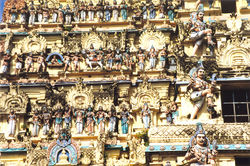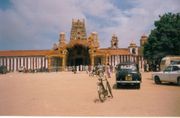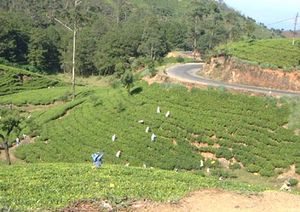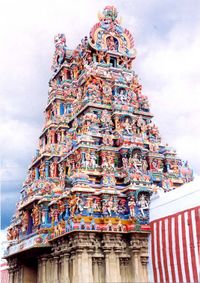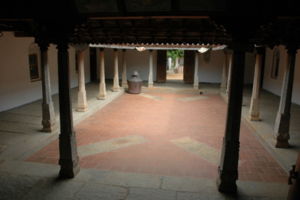Tamil people
2007 Schools Wikipedia Selection. Related subjects: Peoples
| Tamils | |
|---|---|
| Total population | 74,000,000 (1997 estimate) |
| Regions with significant populations | India: 63,000,000 |
| Language | Tamil |
| Religion | Hinduism, Christianity, Islam, Jainism |
| Related ethnic groups | Dravidian people
|
The Tamil people are an ethnic group from South Asia with a recorded history going back more than two millennia. The oldest Tamil communities are those of southern India and northeastern Sri Lanka. There are also a number of Tamil emigrant communities scattered around the world, especially in central Sri Lanka, Malaysia, South Africa and Singapore, with more recent emigrants also found in Australia, Canada, the United States, and parts of Europe.
Unlike many ethnic groups, Tamils were not governed by a single political entity during most of their history; Tamilakam, the traditional name for the Tamil lands, was only politically united for a brief period between the 9th and 12th centuries under the Chola Empire. The Tamil identity is primarily linguistic, with Tamils being those whose first language was Tamil. In recent times, however, the definition has been broadened to include also emigrants of Tamil descent who maintain Tamil cultural traditions, even when they no longer speak the language.
Tamils are ethnically, linguistically and culturally related to the other Dravidian peoples of South Asia. There are an estimated 74 million Tamils around the world.
History
The pre-classical period
The origins of the Tamil people, like those of the other Dravidian peoples, are unknown, although genetic and archaeological evidence suggest a possible migration into India around 6000 BC (Gadgil 1997). Connections with the Elamite people of ancient Iran have been suggested, but there is little solid evidence to support this view. It has also been suggested that the people of the Indus Valley Civilization were either Tamil or another Dravidian people (see e.g. Parpola 1974; 2003), but this theory is deeply controversial and there is at present no academic consensus on the identity of the Indus people.
The earliest clear evidence of the presence of the Tamil people in modern Tamil Nadu (see also History of Tamil Nadu) are the megalithic urn burials, dating from around 1000 BC and onwards, which have been discovered at various places in Tamil Nadu, notably Adichanallur. These burials conform in a number of details to the descriptions of funerals in classical Tamil literature, and appear to be concrete evidence of the existence of Tamils in southern India during that period. Recent excavations at these sites have also provided samples of early Tamil writing, dating back to at least 500 BC (The Hindu, 2005).
The classical period
At around the 3rd century BC onwards, three royal dynasties—the Cholas, the Cheras and the Pandyas—rose to dominate the ancient Tamil country. Each of these dynasties had its own realm within the Tamil-speaking region. Classical literature and contemporary inscriptions also describe a number of vēlīr, or smaller chieftains, who collectively ruled over a large part of central Tamil Nadu. Wars between the kings and the chieftains were frequent, as were wars with Sri Lanka, but these appear to have been fought to assert might and demand tribute, rather than to subjugate and annex those territories. The kings and chieftains were patrons of the arts, and a significant volume of literature exists from this period. The literature shows that many of the cultural practices that are considered peculiarly Tamil date back to the classical period.
Agriculture was important during this period, and there is evidence that irrigation networks were built, including the Kallanai dam, considered to be one of the oldest dams still in use. The economy, however, was centred around foreign trade, and there is evidence of significant contact with Europe. Large hoards of Roman coins and evidence of the presence of Roman traders have been discovered at Karur and Arikamedu, and there is evidence that at least two embassies were sent to the Roman Emperor Augustus by Pandya kings. Potsherds with Tamil writing have also been found in excavations on the Red Sea, suggesting the presence of Tamil merchants there (Mahadevan 2003). An anonymous 1st century traveler's account written in Greek, Periplus Maris Erytraei, describes the ports of the Pandya and Chera kingdoms and the trade with them in substantial detail, and indicates that the chief exports of the Tamils in those days were pepper, malabathrum, pearls, ivory, silk, spikenard, diamonds, sapphires, and tortoiseshell (Casson 1989).
The classical period ended around the 4th century AD with invasions by a northern people referred to as the kaḷvār(kalapirar), who are described as barbarians coming from lands to the north of the Tamil country and being evil and oppressive rulers. This period, commonly referred to as the dark age of the Tamil country, ended with the rise of the imperial Pallava dynasty.
The imperial and post-imperial periods
Although the Pallavas are mentioned in records from the 3rd century, they did not rise to prominence as an imperial dynasty until the 6th century. The dynasty does not appear to have been Tamil in origin, and, although they rapidly adopted Tamil ways and the Tamil language, Tamil society was transformed during their reign. The Pallavas sought to model themselves after great northern dynasties such as the Mauryas and Guptas. They therefore transformed the institution of the kingship into an imperial one, and sought for the first time to bring vast amounts of territory under their direct rule. The Pallavas also encouraged the growth of devotional worship centered around Siva and Vishnu, and began the culture of building large, ornate temples with many murals and sculptures. The caste system is thought to have been formalised and institutionalised during this period (Hart 1987).
The Pallava dynasty was overthrown in the 9th century by the resurgent Cholas and Pandyas. The Cholas become dominant in the 10th century and established an empire covering most of southern India and Sri Lanka. The empire was sustained by strong trading links with China and Southeast Asia. The Cholas were the first dynasty in South India to possess a navy that went as far as Thailand, Burma and Sumatra. A major and successful naval campaign was conducted by the empire against the Srivijaya Empire as a result of trade disputes. Chola power declined in the 12th and 13th centuries, and the Pandya dynasty enjoyed a brief period of resurgence thereafter, but repeated Muslim invasions from the 15th century onwards placed a huge strain on the empire's resources, and the dynasty came to an end in the 16th century (Sastri 2002).
No major empires arose thereafter, and Tamil Nadu was for a while ruled by a number of different local chiefs, such as the Nayaks of the present-day Maharashtra and Andhra Pradesh regions. From the 17th century onwards, European powers began establishing settlements and trading outposts in the region. A number of battles were fought between the British, French and Danish in the 18th century, and by the end of the 18th century most of Tamil Nadu was under British rule.
The western Tamil lands became increasingly politically distinct from the rest of the Tamil lands after the Chola and Pandya empires lost control over them in the 13th century. They developed their own distinct language and literature, which increasingly grew apart from Tamil, evolving into the modern Malayalam language by the 15th century (Chaitanya 1971).
Tamils in Sri Lanka
There is little consensus on the history of the Tamil-speaking parts of Sri Lanka prior to the Chola period. The most radical Sinhalese historians argue that there was no organised Tamil presence in Sri Lanka until the invasions from southern India in the 7th century, whereas many Tamil historians contend that Tamils are the original inhabitants of the island.
The historical evidence is not conclusive either way. A few poems from the Sangam period are attributed to a poet called "Pūtan̲r̲evan̲ār from īl̲am." Il̲am, also spelled Eelam, is an old Tamil name for Sri Lanka, and this is generally used by Tamils as evidence that there were Tamil settlements in Sri Lanka at that time. Sinhalese historians, however, do not accept that and claim that there is no archaeological evidence of Tamil settlement in Sri Lanka until much later. Accounts from that period, whilst not offering conclusive evidence either way, demonstrate that Tamils fought wars against the Sinhalese kingdoms and occasionally ruled over parts of Sri Lanka, and served as counsellors to Sri Lankan kings from a fairly early date. It is, however, unclear whether these Tamils came from India or were native to Sri Lanka.
The historical record does establish that the Tamil kingdoms of India were closely involved in Sri Lankan affairs from a very early date. There is evidence of Tamil traders in Anuradhapura quite early on. Tamil adventurers invaded the island as far back as 75 BC. From the 7th century onwards, the empires of Tamil Nadu played a significant role in Sri Lankan politics, and there is concrete evidence of Tamil settlements in Sri Lanka during that period. Tamil wars against Sri Lanka culminated in the Chola annexation of the island in the 10th century, which lasted until the latter half of the 11th century.
The decline of Chola power in Sri Lanka was followed by the re-establishment of the Polonnaruwa monarchy in the late 11th century. In 1215, the Arya Chakaravarthi dynasty established an independent Jaffna kingdom in the Jaffna peninsula and parts of northern Sri Lanka. The Arya Chakaravarthi expansion into the south was halted by Alagakkonara, a Tamil in the service of the Sinhalese monarch. Alagakkonara built a fortress at Kotte, and held the Arya Chakravarthi army there while he defeated the invading fleet at Panadura. A descendent of Alagakkonara (Tamil-Alagakonar)later became King of the Sinhalese, but this line was deposed by the Ming admiral Cheng Ho (Zheng He) in 1409.
The Arya Chakaravarthi dynasty ruled over large parts of northeast Sri Lanka until 1619, when it was conquered by the Portuguese. The coastal areas of the island was then taken by the Dutch, and in 1796 these became part of the British Empire.
The modern period
The British colonists consolidated the Tamil lands in southern India into the Madras Presidency, which was integrated into British India. Similarly, the Tamil parts of Sri Lanka were joined with the other regions of the island in 1802 to form the Ceylon colony. They remained in political union with India and Sri Lanka after their independence, in 1947 and 1948 respectively.
When India became independent in 1947, Madras Presidency became Madras State, comprised of present-day Tamil Nadu, coastal Andhra Pradesh, northern Kerala, and the southwest coast of Karnataka. The state was subsequently split up along linguistic lines. In 1953 the northern districts formed Andhra Pradesh. Under the States Reorganization Act in 1956, Madras State lost its western coastal districts. The Bellary and South Kanara districts were ceded to Mysore state, and Kerala was formed from the Malabar district and the former princely states of Travancore and Cochin. In 1968, Madras State was renamed Tamil Nadu.
There was some initial demand for an independent Tamil state following the adoption of the federal system. However, the Indian constitution in practice granted significant autonomy to the states, and, protests by Tamils in 1963 led to the government adopting a new policy called the " three language formula," which protects speakers of regional languages from the imposition of Hindi. This has led to Tamils in India becoming increasingly satisfied with the federal arrangement, and there is very little support for secession or independence today.
In Sri Lanka, by contrast, the unitary arrangement led to the slow growth of a feeling amongst Tamils that they were being discriminated against by the Sinhalese majority. This resulted in a demand for federalism, which in the 1970s grew into a movement for independence. The situation deteriorated into civil war in the early 1980s. A ceasefire in effect since 2002 broke down in August, 2006 amid shelling and bombing from both sides.
Geographic distribution
Tamils in India
Most Indian Tamils live in the state of Tamil Nadu, which includes the major part of the former Madras Presidency. The state was given its present borders in 1956, and in 1968, it was given the name Tamil Nadu. Tamils are in clear majority in the union territory of Pondicherry, a former French colony. Pondicherry is a subnational enclave situated geographically within Tamil Nadu.
There are also Tamil communities in other parts of India. Most of these are fairly recent, dating to the colonial and post-colonial periods, but some—particularly the Hebbar and Mandyam Tamils of southern Karnataka, the Tamils of Palakkad in Kerala, and the Tamils of Pune, Maharashtra—date back to at least the medieval period.
Tamils in Sri Lanka
There are today two groups of Tamils in Sri Lanka. The first are the Sri Lankan Tamils, who are descended from the Tamils who lived in the old Jaffna kingdom or who migrated to the East coast. The second are the Indian origin Tamils or Hill Country Tamils, who are descended from bonded labourers sent from Tamil Nadu to Sri Lanka in the 19th century to work in tea plantations there. Ceylon Tamils mostly live in the northern and eastern provinces, whereas hill-country Tamils largely live in the central highlands. The hill-country Tamils and Ceylon Tamils historically have seen themselves as separate communities.
In 1949, the United National Party Government, which included GG Ponnabalam, a leader of the Tamil Congress and of the Sri Lankan Tamils, stripped the Indian Tamils of their nationality, including their right to vote. But it should be noted the prominent Tamil political leader S.J.V Chelvanayagam and his Tamil opposition party that represented the political will of most Sri Lankan Tamils opposed this vote.
Under an agreement between the Sri Lankan and Indian governments in the 1960s, around 40% of hill-country Tamils were granted Sri Lankan nationality, and many of the remainder were repatriated to India. However, the ethnic conflict has led to the growth of a greater sense of common Tamil identity, and the two groups are now more supportive of each other (Suryanarayan 2001). By the 1990s most Indian tamils had received Sri Lankan citizenship.
The late MG Ramachandran, the Tamil film star, former Chief Minister of Tamil Nadu and founder of the All India Anna Dravida Munnetra Kazhagam, was an Indian born to Malayalee parents from Sri Lanka. Conversely, the late Saumyamurthy Thondaman, the leader of the Ceylon Workers' Congress, was born in India.
There is also a significant Tamil-speaking Muslim population in Sri Lanka. Unlike Tamil-speaking Muslims from India, however, they do not identify themselves as ethnic Tamils and are therefore usually listed as a separate ethnic group in official statistics. Those of Indian origin (Indian Moors) are rarely listed separately from those of Sri Lankan origin.
Tamil emigrant communities
Mass Tamil emigration began in the 18th century, when many poor Tamils were sent as bonded labourers to far-off parts of the British Empire, especially Malaya, South Africa, Fiji, Mauritius and the Caribbean. At about the same time, many Tamil businessmen also emigrated to other parts of the British Empire, particularly Burma and East Africa. Many Tamils still live in these countries, and the Tamil communities in Singapore, Reunion Island, Malaysia and South Africa have retained much of their culture and language. Many Malaysian children attend Tamil schools, and a significant portion of Tamil children in Mauritius, Reunion and Singapore are brought up with Tamil as their first language. To preserve the Tamil language, the Singapore government has made it a national language despite the fact that Tamils make up only about 4.2% of the population, and has also introduced compulsory instruction on the language for Tamils. Other Tamil communities, such as those existing in South Africa, no longer speak Tamil as a first language, but still retain a strong Tamil identity.
A large emigration also began in the 1980s, as Sri Lankan Tamils sought to escape the ethnic conflict there. These recent emigrants have most often fled to Australia, Europe, North America and Southeast Asia. Today, the largest concentration of Tamils outside southern Asia is in Toronto, Canada.
Many young Tamil professionals from India, particularly computer programmers, have also emigrated to Europe and the United States in recent times in search of better opportunities. These new emigrant communities have established cultural associations to protect and promote Tamil culture and language in their adopted homes.
Culture
Language and literature
Tamils have strong feelings towards the Tamil language, which is often venerated in literature as "tamil̲an̲n̲ai," "the Tamil mother." It has historically been, and to large extent still is, central to the Tamil identity (Ramaswamy 1998). Like the other languages of South India, it is a Dravidian language, unrelated to the Indo-European languages of northern India. The language has been far less influenced by Sanskrit than the other Dravidian languages, and preserves many features of Proto-Dravidian, though modern-day spoken Tamil, especially in Tamil Nadu, freely uses loanwords from Sanskrit and English. Tamil literature is of considerable antiquity, and the language was recently recognised as a classical language by the government of India.
Classical Tamil literature, which ranges from lyric poetry to works on poetics and ethical philosophy, is remarkably different from contemporary and later literature in other Indian languages, and represents the oldest body of secular literature in South Asia (Hart 1975). Notable works in classical Tamil literature include the Tirukkural by Tiruvalluvar, the five great Tamil epics and the works of Auvaiyar. The written language has changed very little over the years, with the result that much of classical literature remains easily accessible to modern Tamils and continues to influence modern Tamil culture.
Modern Tamil literature is considerably diverse, ranging from Indian Nationalism in the works of Subramanya Bharathy, to historical romanticism in the works of Kalki Krishnamurthy, to radical and more moderate social realism in the works of Pudhumaipithan and Jayakanthan respectively, to feminism in the works of Malathi Maithree and Kutti Revathi. Sujatha, an author whose works range from romance novels to science fiction, is one of the most popular modern writers using the Tamil language. In more recent years, Sri Lankan Tamil literature has produced several powerful pieces reflecting the civilian tragedy caused by decades of war. There is also an emerging diaspora literature in Tamil.
Visual art and architecture
Tamil visual art displays considerable unity across its three main forms, architecture, sculpture and painting, and is clearly situated within the South Asian artistic tradition. As with other South Asian art, Tamil art stresses the plasticity and fluidity of forms. Most traditional Tamil art is at least nominally religious, usually centred on Hinduism, although the religious element is often only a means to represent universal—and, occasionally, humanist—themes (Coomaraswamy 1946). The classical art forms continue to be practiced, and therefore represent a living tradition.
The most important form of Tamil painting is Tanjore painting, which, as the name suggests, originated in Tanjore (now Thanjavur) in the 9th century. The paintings are prepared on a base of cloth coated with zinc oxide, over which the image is painted using dyes and decorated with semi-precious stones and gold or silver thread. A style which is related in origin, but which exhibits significant differences in execution, is used for painting murals on temple walls, the most notable example being the murals on the Mīn̲āṭci temple of Madurai. Tamil painting in general is known for its stylistic elegance, rich colours and attention to small details.
Tamil sculpture is usually worked with bronze (using the lost wax technique) or stone (usually associated with temples), and surviving pieces date from the 7th century onwards. Unlike most Western art, the material in Tamil sculpture does not influence the form taken by the sculpture; instead, the artist imposes his vision of the form on the material. As a result, one often sees in stone sculptures the sort of flowing forms that would normally be reserved for metal (Sivaram 1994). As with painting, these sculptures show a fine eye for detail, with great care being taken in sculpting minute details of jewellery worn by the subjects of the sculpture. The lines tend to be smooth and flowing, and many pieces capture movement with great skill. The cave sculptures at Mamallapuram are a particularly fine example of the technique, as are the bronzes of the Chola period. A particularly popular motif in the bronzes was the depiction of Siva as Nataraja, in a dance posture with one leg upraised and a fiery circular halo surrounding his entire body.
Tamil temples were often simply treated as sculptures on a grand scale. The temples are most notable for their high spires, known as Gopura, consisting of a number of stepped levels, each with its own miniature shrine. These spires tended to be simple and elegant and only sparsely adorned with sculpture in the earliest temples, but they became progressively more elaborate and ornate, as exemplified by the Brihadīsvara temple of Thanjavur. From the 13th century onwards, the entrance gates to the temples—called gopurams in Tamil—also began to grow bigger and more elaborate. The temples at Chidambaram and Srirangam have particularly impressive gopurams, covered with sculptures and reliefs of various scenes and characters from Hindu mythology (Pillai 1976).
As with Indian art in general, Tamil art does not traditionally aspire to portraiture or realism. Much more emphasis is placed on the representation of ideal prototypes and on depicting the symbols with which the theme of the artistic work is associated. This means that small details, such as the direction which a hand faces, the animals or trees portrayed, or the time of day depicted, are often of critical importance to understanding the meaning of a work of art.
Performing arts
The traditional Tamil performing arts have ancient roots. The royal courts and temples have been centres for the performing arts since at least the classical period, and descriptions of performances in classical Tamil literature and the Natya Shastra, a Sanskrit treatise on the performing arts, indicate a close relationship between the ancient and modern artforms. Much like other Indian traditions, Tamil tradition stresses the unity of the various performance arts, and their symbiotic relationship with the visual arts and literature. The aim of a performance in Tamil tradition is to bring out the rasa—the flavor, mood, or feeling—inherent in the text, and its quality is measured by the extent to which it induces the mood in the audience.
Tamil shares a classical musical tradition, called carnatic music, with the rest of South India. Carnatic music evolved from the ancient music forms of South India, some of which are recorded in classical Tamil literature, and was influenced by the musical theory of the Natya Shastra. It is primarily oriented towards vocal music, with instruments functioning either as accompaniments or imitating the role of the singer. Carnatic music is organized around the twin notions of melody types (rāgam) and cyclical rhythm types (thāḷam). Unlike the northern Hindustani music tradition, carnatic music is almost exclusively religious.
In sharp contrast with the restrained and intellectual nature of carnatic music, Tamil folk music tends to be much more exuberant. Popular forms of Tamil folk music include the Villuppāṭṭu, a form of music performed with a bow, and the Nāṭṭuppur̲appāṭṭu, ballads that convey folklore and folk history. Some of the leading Tamil folk artists in the early 21st century are Pushpuvanam Kuppuswamy and his wife Anitha, and Chandramukhi Chinnaponnu.
The dominant classical dance amongst Tamils is Bharatanatyam. Bharatanatyam is performative rather than participative. A dance is an exposition of the story contained in a song, and is usually performed by one performer on stage, with an orchestra of drums, a drone, and one or more singers backstage. The story is told through a complicated combination of mudras (hand gestures), facial expressions, and body posture. The dance form evolved from a specialized form of temple-dancing, and was only performed in temples until the 1930s. Dancers used to be exclusively female, but the dance now also has several well-known male practitioners.
Tamils also have a large number of folk dances. The most celebrated of these is karakāṭṭam. In its religious form, the dance is performed in front of an image of the goddess Mariamma. The dancer bears on his or her head a brass pot filled with uncooked rice, decorated with flowers and surrounded by a bamboo frame, and tumbles and leaps to the rhythm of a song without spilling a grain. Karakāṭṭam is usually performed to a special type of song known as temmanguppāṭṭu or thevar pāṭṭu, a folk song in the mode of a lover speaking to his beloved, to the accompaniment of a nadaswaram and melam. Other Tamil folk dances include mayilāṭṭam, where the dancers tie a string of peacock feathers around their waist; ōyilāttam, danced in a circle while waving small pieces of cloth of various colors; poykkāl kuthiraiyaaṭṭam, where the dancers use dummy horses; mān̲āṭṭam, where the dancers imitate the graceful leaping of deer; par̲aiyāṭṭam, a dance to the sound of rhythmical drumbeats, and thīppandāṭṭam, a dance involving playing with burning wooden torches. (Sharma 2004).
Tamil dance is closely intertwined with the Tamil theatrical tradition. Most art forms include a blend of both. The kuravañci is a type of dance-drama, performed by four to eight women. The drama is opened by a woman playing the part of a female soothsayer of a wandering kurava tribe, who tells the story of a lady pining for her lover. The songs themselves have a lyrical beauty, which is amplified by the performance.
The therukkūthu (which literally means "street play") is a form of village theatre or folk opera. It is traditionally performed in village squares with no sets and very simple props. The performances involves songs and dances, sometimes at the same time, and the stories can be either religious or secular. The performances are not formal, and performers often interact with the audience, mocking them or involving them in the dialogue. Therukkūthu has in recent times been very successfully adapted to convey social messages, such as abstinence and anti- caste criticism, as well as information about legal rights, and has spread to other parts of India.
The village of Melatur in Tamil Nadu has a special type of performance, called the bhagavatamela, in honour of the local deity, which is performed once a year and lasts all night. Tamil Nadu also has a well developed stage theatre tradition, which has been heavily influenced by western theatre. A number of theatrical companies exist, with repertoires includes absurdist, realist and humorous plays.
Both classical and folk performing arts survive in modern Tamil society. The folk arts declined during the middle of the 20th century, but have seen a resurgence in recent years, particularly in southern Tamil Nadu, although their popularity continues to be largely confined to rural regions. The Tamil Nadu Folk Arts Society (or "Tamil̲nāṭu iyalisai nāṭaka man̲r̲am") is dedicated to the preservation and promotion of the folk arts, and has played a significant role in the continuance of the tradition.
Tamil people in Tamil Nadu are also passionate about their cinema. The Tamil film industry, commonly dubbed Kollywood, is the second-largest film industry in India. Tamil cinema is appreciated both for its technical accomplishments and for its artistic and entertainment value.
The overwhelming majority of Tamil films contain song and dance sequences, and Tamil film music is a popular genre in its own right, often liberally fusing elements of Carnatic, Tamil folk, North Indian styles, hip-hop, and heavy metal. Famous music directors of the late 20th century included M. S. Viswanathan, Ilayaraaja and A R Rahman.
Religion
Most Tamils are Hindus, but Islam and Christianity also have presence in Tamil Nadu. Tamils worship Lord Muruga as their God. He is called as Tamil Kadavul. Jainism was at one time a major religious force in Tamil Nadu, but it declined substantially during the Pallava period, and there are now only a few thousand Tamil Jains.
Tamil Hinduism, like other regional varieties of Hinduism, has many peculiarities. The most popular deity is Murugan, who has from a very early date been identified with Karthikeya, the son of Siva, but who may in origin have been a different deity (Hart 1979), and has taken on a distinctly local character. The worship of Amman or Mariamman, thought to have been derived from an ancient mother goddess, also is very common. Kan̲n̲agi, the heroine of the Cilappatikār̲am, is worshipped as Paṭṭin̲i by many Tamils, particularly in Sri Lanka. There are also many temples and devotees of Vishnu, Siva, Ganapathi, and the other common Hindu deities.
The most important Tamil festivals are Pongal, a harvest festival that occurs in mid-January, and varuḍapir̲appu, the Tamil New Year, which occurs around mid-April. Both are celebrated by almost all Tamils, regardless of religion. The hindu festival Deepavali is celebrated with fanfare. Some Tamil Hindu festivals include Thaipusam, and Adipperukku.
The indigenous religion of rural Tamil Nadu has many local deities called aiyyan̲ārs, who are thought to be the spirits of local heroes who protect the village from harm. Their worship often centers around naḍukkals, stones erected in memory of heroes who died in battle. This form of worship is mentioned frequently in classical literature and appears to be the surviving remnants of an ancient Tamil tradition.
Saivism, is particularly strong although most of its bases are in the North. The Alvars and Nayanars, who were predominantly Tamils, played a key role in the renaissance of Bhakti tradition in South India. In the 10th century, the philosopher Ramanuja who propagated the theory of Visishtadvaitam brought lot of changes to worshiping practices, creating new regulations on temple worship and accepting lower-caste Hindus as his prime disciples. Other notable Tamil spiritualists include Vallalar, Ramana Maharshi, and the Siddhars, a group of yogic practitioners. The system of Siddha medicine is also associated with Tamil Shaivism. Ramayana has many parts based in Tamil regions and according to legends, many of Rama's soldiers were Tamil. The only temple dedicated to Parashurama is in Tamil Nadu.
Martial arts
According to Tamil legend, the Chola, Chera and Pandya kings fought a hundred-year war at the beginning of the 1st century, during which they perfected the art of fighting. Various martial arts are believed to have evolved from this, including Kuttu Varisai, Varma Kalai, Silambam Nillaikalakki, Maankombukkalai (Madhu) and Kalarippayattu, all of which are still practised today in parts of Tamil Nadu and Kerala. While the most recent art called Kalarippayattu of Kerala includes weapons, each weapon in Tamil Nadu is a mastery of itself. Not only is there Silambam and Maankombukkalai (madhu), there is, Yeratthai Mulangkol (double stick), Surul Pattai (spring sword), Val Vitchi (single sword), and Yeretthai Val (double sword). These are just a few amongst the many other weapons used.
Silambam Nillaikalakki is the art of staff combat, and uses a staff 1.6 metres long. Its techniques were designed to enable a person to use a traveller's walking-staff to defend himself against an attack by several enemies. Its techniques focus on using the staff without stopping its movement, and synchronising staff, foot and body motion. Kuttuvarisai is a martial art which teaches empty hand combat employing the hands and legs. Varma Kalai is a martial art which trains people to attack the vital points of an opponent's body with hands or weapons. maankombukkalai involves fighting with a weapon made from the antlers of a stag tipped with metal. Kalarippayattu focus on all aspects of fighting, including unarmed combat and combat with wooden and metal weapons. The Kalarippayattu tradition is strongest in Kerala, where it is known as Kalaripayattu.
The ancient Tamil art of unarmed bullfighting, popular amongst warriors in the classical period, has also survived in parts of Tamil Nadu, notably Alanganallur near Madurai, where it is known as Jallikaṭṭu or mañcuviraṭṭu and is held once a year around the time of the Pongal festival.
Institutions
Because Tamils have been spread over several countries for much of their history, there are few formal pan-Tamil institutions. The most important national institutions for Tamils have been the governments of the states where they live, particularly the government of Tamil Nadu and the government of Sri Lanka, which have collaborated in developing technical and scientific terminology in Tamil and promoting its use since the 1950s.
Politics in Tamil Nadu is dominated by the Self-respect Movement (also called the Dravidian movement), a movement founded by E.V. Ramasami, popularly known as Periyar, to promote self-respect and rationalism, and to fight casteism and the oppression of the lowest castes. Every major political party in Tamil Nadu bases its ideology on the Self-respect Movement, and the national political parties play a very small role in Tamil politics.
In Sri Lanka, Tamil politics was dominated by the federalist movements, led by the Federal Party (later the Tamil United Liberation Front), until the early 1980s. In the 1980s, the political movement was largely succeeded by a violent military campaign conducted by several militant groups. The Liberation Tigers of Tamil Eelam emerged as the most important force amongst these groups in the 1990s, and is currently negotiating a final settlement with the government. The LTTE controls portions of Sri Lanka, and has attempted to establish its own government there, which it calls the government of Tamil Eelam. LTTE has been banned by the European Union on account of alleged terrorism. It has also been banned in India following the assassination of former Prime Minister Rajiv Gandhi.
In the 1960s, the government of Tamil Nadu held a World Tamil Conference, and have continued to meet periodically since then. In 1999, a World Tamil Confederation was established to protect and foster Tamil culture and further a sense of togetherness amongst Tamils in different countries. The Confederation has since adopted a Tamil flag and Tamil song to act as trans-national symbols for the Tamil people; the words on the flag quote the opening line of a poem by the classical poet Kanian Poongundranaar, and means "Whosoever is our kin;Wheresoever is our home"
